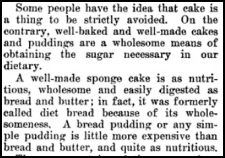Or diet bread cake.
An early American recipe for Sponge cake is in Lydia Maria Francis Child‘s The Frugal Housewife, from 1829:
|
Sponge Cake.
The nicest way to make sponge cake, or Diet-bread, is the weight of six eggs in sugar, the weight of four eggs in flour, a little rose water. The whites and yolks should be beaten thoroughly and separately. The eggs and sugar should be well beaten together; but after the flour is sprinkled it should not be stirred a moment longer than is necessary to mix it well; it should be poured into the pan, and got into the oven with all possible expedition. Twenty minutes is about long enough to bake. Not to be put in till some other articles have taken off the first few minutes of furious heat. |
See? “Diet-bread.” We should probably talk about that. This is another time where you can find some really poor reasoning on food blogs, but this is one of the rare times when the usually great foodtimeline.org provides gibberish:
A late 19th century article suggests diet bread was sometimes pronounced as “dier” or “dyer.” The OED defines the word “dier” is as someone who is dying. We might infer from this historic observation “diet bread” was recommended for young folks over richer cakes. […] This makes sense.
No, no it doesn’t.
The late 18th century piece it cites is “Out of Old Salem Cupboards” from the February 1886 edition of the Atlantic Monthly. That’s Salem, as in Salem, Massachusetts. As in New England.
As in a place with a distinctive accent that includes, among other things, the occasional replacement of the letter ‘t’ in words and phrases with a glottal stop, particularly if a word ending it “t” is followed by a word starting with a hard consonant. (To put that in plain English, imagine Ben Affleck and Matt Damon in their Boston accents saying “Meat cutter?” and “Quiet boys!” quickly back and forth.)
So, no, not “dyer” bread, diet bread. A more plausible explanation was provided by Sara Shorter Alexander from Columbia University’s Teachers College in an article from the January 1910 edition of Good Housekeeping titled “Doughs: Their Successful Use:”
|
Some people have the idea that cake is a thing to be strictly avoided. On the contrary, well-baked and well-made cakes and puddings are a wholesome means of obtaining the sugar necessary in our dietary.
A well-made sponge cake is as nutritious, wholesome and easily digested as bread and butter; in fact, it was formerly called diet bread because of its wholesomeness. A bread pudding or any simple pudding is little more expensive than bread and butter, and quite as nutritious. |
Whether she’s right, I can’t say, but it does seem a more reasonable explanation. They are, after all, mostly eggs.
One interesting last wrinkle–some British sources list diet bread and sponge cake as slightly different recipes. As far as I can tell, these terms were used interchangeably in American cooking.
From the box of A.D. from Lutz, Florida, by way of Pennsylvania in the 1940s, and originating in Ohio in the 1920s.
Golden Sponge Cake
1-1/4 cups white sugar
3/4 cup water
7 eggs, whites and yolks separated
1 cup cake flour
pinch salt
1 tsp. cream of tartar
1 tsp. vanilla
Boil sugar and water until it spins thread. Beat egg yolks until thick and pour over them slowly the boiling syrup. Beat until cool. Add flour.
Whip whites until stiff. Add salt and cream of tartar. Mix well, then fold into first mixture; add flour.
Pour into ungreased pans and bake 1 hour. Cover with boiled white icing.



